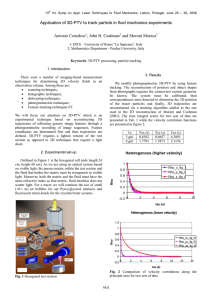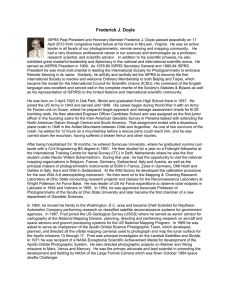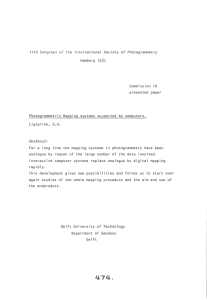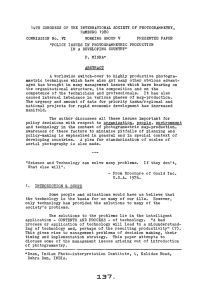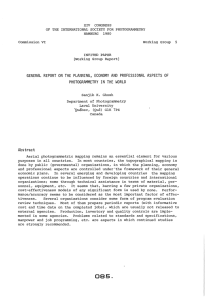HIIII
advertisement
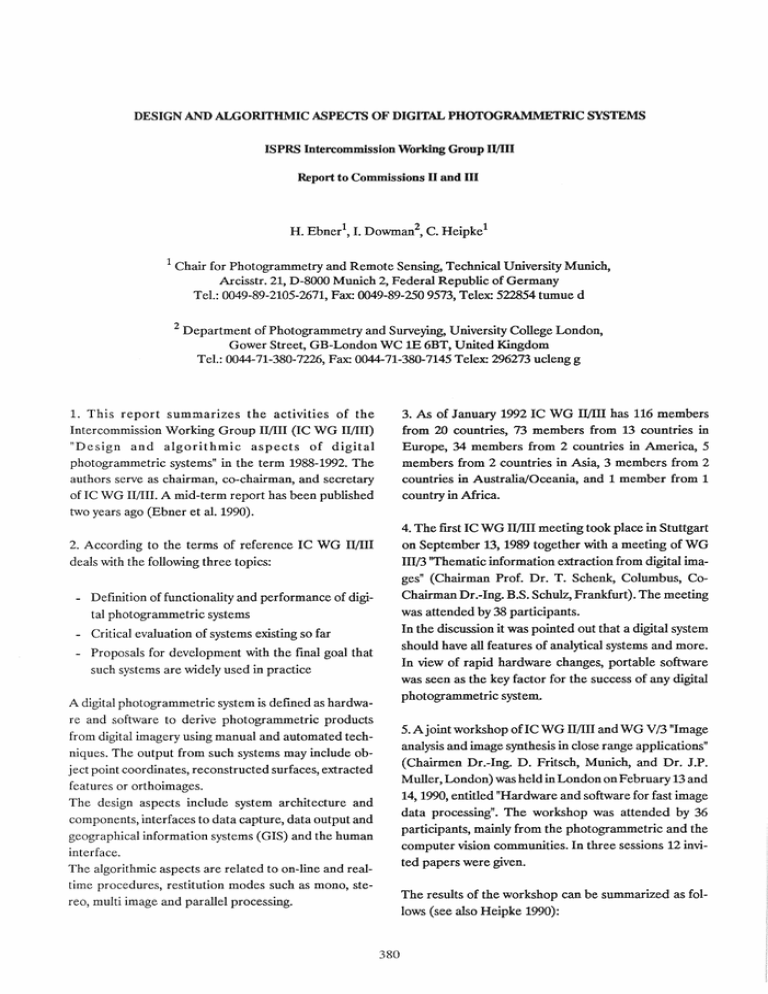
DESIGN AND ALGORITHMIC ASPECfS OF DIGITAL PHOTOGRAMMETRIC SYSTEMS ISPRS Intercommission Working Group HIIII Report to Commissions H and HI H. Ebner 1, I. Dowman2, C. Heipke1 1 Chair for Photogrammetry and Remote Sensing, Technical University Munich, Arcisstr. 21, D-8000 Munich 2, Federal Republic of Germany Tel.: 0049-89-2105-2671, Fax: 0049-89-2509573, Telex: 522854 tumue d 2 Department of Photogrammetry and Surveying, University College London, Gower Street, GB-London WC 1E 6BT, United Kingdom Tel.: 0044-71-380-7226, Fax: 0044-71-380-7145 Telex: 296273 ucleng g 3. As of January 1992 IC WG IIIIII has 116 members from 20 countries, 73 members from 13 countries in Europe, 34 members from 2 countries in America, 5 members from 2 countries in Asia, 3 members from 2 countries in Australia/Oceania, and 1 member from 1 country in Africa. 1. This report summanzes the activities of the Intercommission Working Group II/III (IC WG II/III) "Design and algorithmic aspects of digital photogrammetric systems" in the term 1988-1992. The authors serve as chairman, co-chairman, and secretary of IC WG II/III. A mid-term report has been published two years ago (Ebner et al. 1990). 4. The fIrst IC WG II/III meeting took place in Stuttgart on September 13, 1989 together with a meeting of WG III/3 "Thematic information extraction from digital images" (Chairman Prof. Dr. T. Schenk, Columbus, CoChairman Dr.-Ing. B.S. Schulz, Frankfurt). The meeting 2. According to the terms of reference IC WG IIIIII deals with the following three topics: - Definition of functionality and performance of digital photogrammetric systems was attended by 38 participants. In the discussion it was pointed out that a digital system should have all features of analytical systems and more. In view of rapid hardware changes, portable software was seen as the key factor for the success of any digital photogrammetric system. - Critical evaluation of systems existing so far - Proposals for development with the fmal goal that such systems are widely used in practice A digital photogrammetric system is defmed as hardware and software to derive photogrammetric products from digital imagery using manual and automated techniques. The output from such systems may include object point coordinates, reconstructed surfaces, extracted features or orthoimages. The design aspects include system architecture and components, interfaces to data capture, data output and geographical information systems (GIS) and the human interface. The algorithmic aspects are related to on-line and realtime procedures, restitution modes such as mono, stereo, multi image and parallel processing. 5. A joint workshop ofIC WG 1I/I1I and WG V/3 "Image analysis and image synthesis in close range applications" (Chairmen Dr.-Ing. D. Fritsch, Munich, and Dr. J.P. Muller, London) was held in London on February 13 and 14,1990, entitled "Hardware and software for fast image data processing". The workshop was attended by 36 participants, mainly from the photogrammetric and the computer vision communities. In three sessions 12 invited papers were given. The results of the workshop can be summarized as follows (see also Heipke 1990): 380 - Instead of special hardware, off-the-shelf products are mainly used for digital photogrammetric workstations (DPWS). Furthermore, contacts were established in Dresden with other WGs of Commission II, in particular with WG IllS. - An increasing use of transputers, transputer based systems and of the RISC architecture can be observed. 10. From March 21 to 22, 1991 a workshop on "Design issues of softcopy photogrammetric workstations" was held in Boulder, Colorado. It was well organized by Dr. F. Leberl, President of Vexcel Corporation, Boulder, who attracted a total of 57 participants. The workshop was intended to give an overview of the North American developments in DPWS. Accordingly, 12 out of the 13 invited papers were given by speakers from the US and Canada. Summaries of the workshop have been published in scientific journals (Case 1991; Dowman 1991; - Digital image matching algorithms can be successfully applied to satellite and small scale images, as well as to images taken in especially controned environment in close range applications. Further work is needed for large scale images. - Further research and development is necessary in feature extraction and for the efficient paraIlelisation of algorithms. Fuchs 1991). A number of trends can be extracted from the presentations and the discussion: Minutes of the workshop are available from University College London (Dowman 1990). .. DPWS have been produced in North America for more· than a decade for military purposes. These systems were characterized by high functionality, high performance, hardwired processing, and high cost. 6. At the Symposium of Commission IV, held in Tsukuba from May 15 to 17, 1990 several papers on digital stereo systems and on digital orthoprojection were presented. They are included in the proceedings. - Today there exists a number of civilian general purpose DPWS such as the Intergraph ImageStation, the Autometric Pegasus, or the Matra Traster. They offer most of the functionality of analytical plotters, and in addition image processing, and digital orthoprojection software. Software for image matching is available, or is being announced. Problems still exist for large scale applications. 7. During the Symposium of Commission HI, held in Wuhan from May 22 to 25, 1990 the second IC WG II/IH meeting took place on May 23. In the closing session on May 25 a report was given on the progress in work and research of IC WG HnII. The great importance of algorithmic aspects was emphasised. From this point of view, many of the papers presented at the Symposium were rdated to IC WG HnII. Moreover, in Wuhan contacts were established and renewed with WGs HI/I, 2, 3, and 4 to guarantee that the progress achieved in Commission HI can be utilized by IC WG HnII. - Orthoimage workstations such as the PRI2SM system from 12S, the HAl 500 and the HAl 750 from Helava Inc., and the Orthomap from Galileo Siscam which provide digital orthoprojection, and capabilities for monoplotting are available on the market. Software for image matching is partly available, or is being announced. 8. At the Symposium of Commission V, held in Zurich from September 3 to 7, 1990 several papers on digital photogrammetric systems were presented. They are in- - PC workstations for photogrammetric tasks such as the DMS (Digital Mapping System) from R. Welch or the DVP (Digital Video Plotter) from Laval University, now marketed by Leica, have found their place as inexpensive alternatives inside and outside the photogrammetric community. cluded in the proceedings. 9. During the Symposium of Commission H, held in Dresden from September 8 to 12, 1990 one session was devoted to IC WG HnII. In total, 5 papers were presented in this session. Three additional papers were strongly related to the subject of IC WG HnH. In the closing session on September 12 a report was given on the work of IC WG Hnn. The characteristics of the different experimental and commercial systems with respect to interactivity and the application domain were discussed. .. Automated feature extraction in spite of impressive improvements still needs a lot of research and development in order to be incorporated into a DPWS. 381 tools are available on a research and development level. The papers of the workshop have been published in a special issue of Photogrammetric Engineering and Remote Sensing (PE&RS 1992). 11. The ISPRS Conference on "Digital Photogrammetric Systems" was held at the Technical University Munich from September 3 to 6, 1991. The conference covered all aspects of the working group and was attended by 135 participants from 16 countries. 29 invited speakers presented their papers in 11 sessions. The first day was dedicated to tutorials. Reports of the conference have appeared in scientific journals (Colomina 1992; Peipe 1992; Pross 1992).The main topics addressed were design and algorithmic aspects of digital photogrammetric systems, the vendor's and user's view of operational systems, and relations to GIS, remote sensing, computer graphics and machine vision. The main results are: - In the transition from analytical to digital photogrammetry traditional photogrammetric instruments are becoming obsolete. In future the photogrammetric knowledge will go more and more into software instead of hardware. - There is a growing need for end-to-end systems. System integration rather than the development of special solutions will become very important in the future. - DPWS are increasingly being assembled with standard off-the-shelf components in order to facilitate software portability across different hardware platforms. - A D PWS can be seen as a front end system for the acquisition of GIS or CAD data. It also acts as an active window into the GIS data base. - Large users such as government mapping agencies are starting to use digital photogrammetry and DPWS. Digital orthoprojection is becoming popular. - Image matching has made good progress by using multi image object based approaches and hierarchical representations, e.g. image pyramids. More work is needed to robustify the algorithms and for large scale applications. - Image understanding, while successful in special applications, must be supported by a human operator in the foreseeable future. Exciting interactive - There is a need from the image understanding community for easy-to-use photogrammetric 'black boxes'. Along these lines computer vision and photogrammetry are increasingly working together. The proceedings of the conference have been published in the Wichmann Verlag, Karlsruhe (Ebner et al. 1991). The tutorial notes (R-.!nz et ale 1991) are available from the working group secretary. 12. XVII ISPRS Congress, Washington DC. 1992 During the Washington Congress four sessions involving IC WG II/III are planned: Design and algorithmic aspects of digital systems Commission H, Session Organizer: H. Ebner Algorithms and software concepts for digital photogrammetric workstations together with WG H/5, WG V/3 Commission H, Session Organizer: H. Ebner Tomorrow's digital systems together with WG H/5, WG III/2, WG III/4, WG V/1 Commission H, Session Organizer: I. Dowman Image analysis and synthesis in on-line applications together with WG III/2, WG V/3 Commission V, Session Organizer: D. Fritsch 13. Conclusions The technical conclusions of the work of IC WG H/IH in the term 1988-92 have been given in conjunction with the three meetings in London, Boulder, and Munich. They shall not be repeated in detail here. In summary digital photogrammetric workstations are well on their way to replace analytical plotters for topographic mapping. However, this transition from analytical to digital photogrammetry will take its time. Today DPWS are accepted for specific tasks with demonstrated cost efficiency, this means for orthoimage production, as a front end data acquisition system for GIS, and for revision tasks in a small production environment. The more powerful, expensive workstations are only being used in environments were cost is of minor importance. Their wider acceptance must await the development of 382 Peipe J., 1992: ISPRS-Konferenz Digitale Photogrammetrische Systeme, ZPF (60),1,34-36. PE&RS, 1992: Special Issue on Design Issues of Softcopy Photogrammetric Workstations, PE&RS (58) 1. Pross E., 1992: Digitale photogrammetrische Systeme, ZfV (117),1,69-70. Renz H., Arnan F., Baltsavias E., Forstner W., 1991: Tutorial, ISPRS Conference on digital photogrammetric systems, Chair for Photogrammetry and Remote Sensing, Technical University Munich. robust image matching and feature extraction algorithms. Some proposals for the further development of digital photogrammetric systems have been formulated. They include: - open systems and greater portability of software, - faster display for stereo viewing including continuous roaming, zooming, and image rotation, - improved possibilities for interactive measurement of image coordinates with subpixel accuracy, - simultaneous use of more than two digital images, - use of data from different sensors, - continued development of algorithms for robust image matching and feature extraction, - improved integration with GIS, - improved human interface. Also a comparison of the different systems in terms of cost and performance has still to be undertaken. 14.References Case J., 1991: Report on the workshop Design issues of soft copy photogrammetric workstations, PE&RS (57) 9, 1227-1228. Colomina I., 1992: ISPRS Conference on digital photogrammetric systems, ISPRS JPhRS (47), to be published. Dowman 1. (Ed.), 1990: Proceedings of the joint workshop Hardware and software for fast image data processing, Department of Photogrammetry and Surveying, University College London. Dowman L, 1991: Digital photogrammetric systems in North America, PhRec (13) 78,931-934. Ebner H., Dowman I., Heipke C., 1990: ISPRS Intercommission Working Group II/III Design and algorithmic aspects of digital photogrammetric systems, Report to Commission II, IntArchPhRS (28) 2,387390. Ebner H., Fritsch D., Heipke C. (Eds.), 1991: Digital Photogrammetric Systems, Wichmann Verlag,Karlsruhe. Fuchs C., 1991: Design issues of softcopy photogrammetric workstations, ISPRS JPhRS (46), 247-249. Heipke C., 1990: Joint workshop on Hardware and software for fast image data processsing, ISPRS JPhRS (45), 289-290. 383


